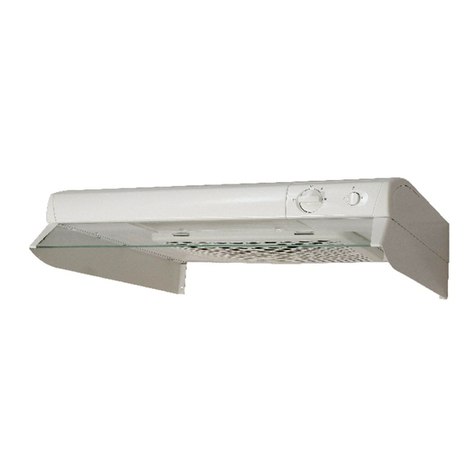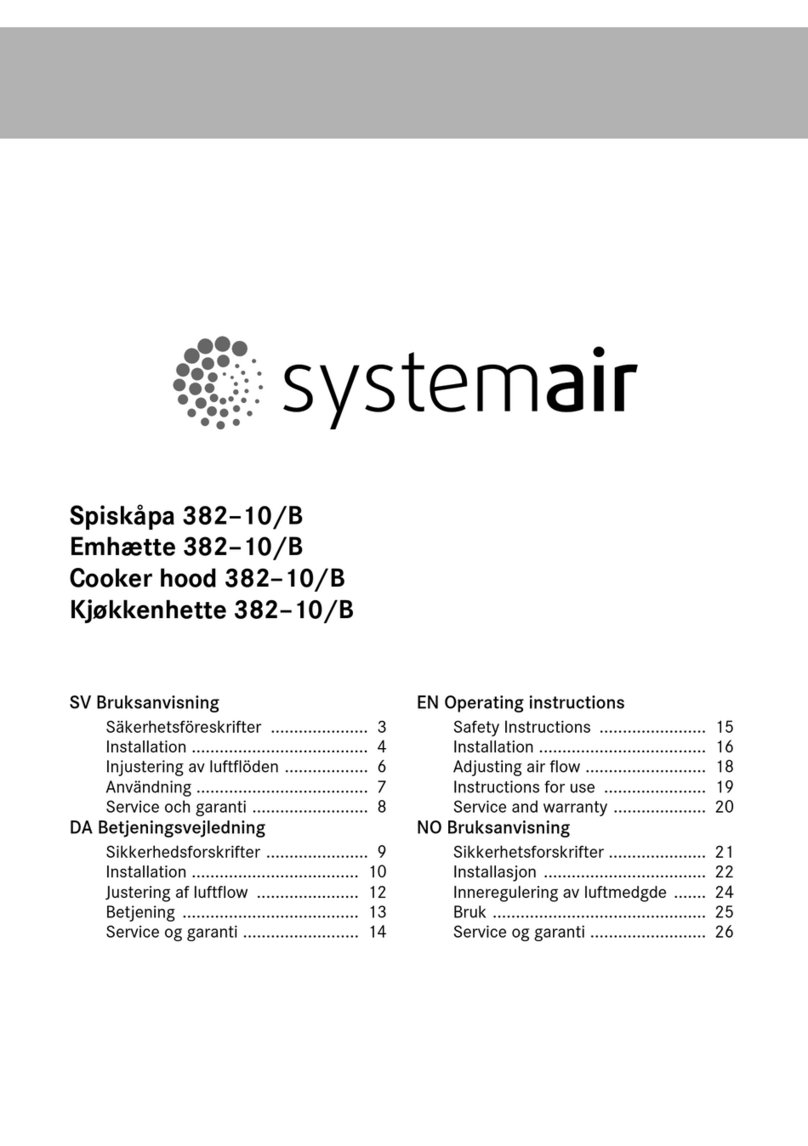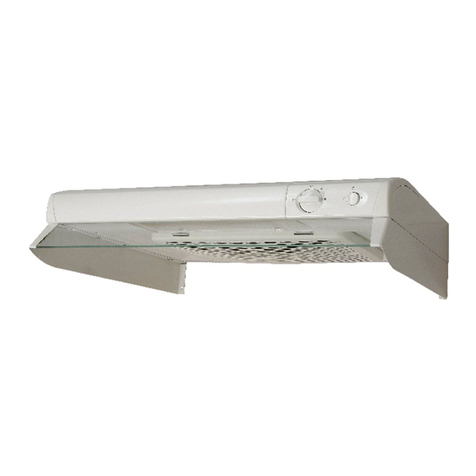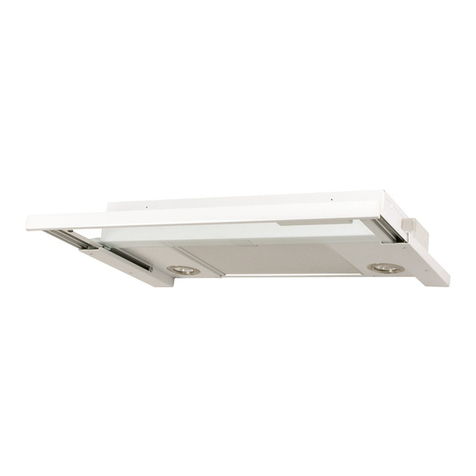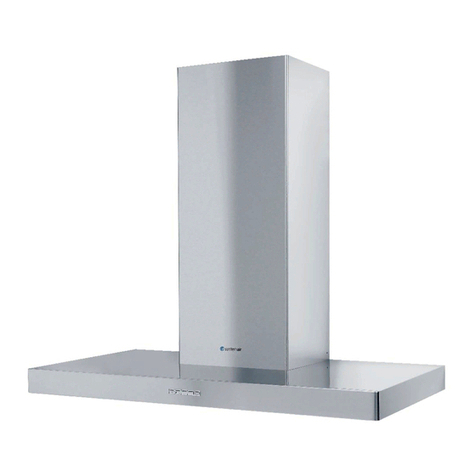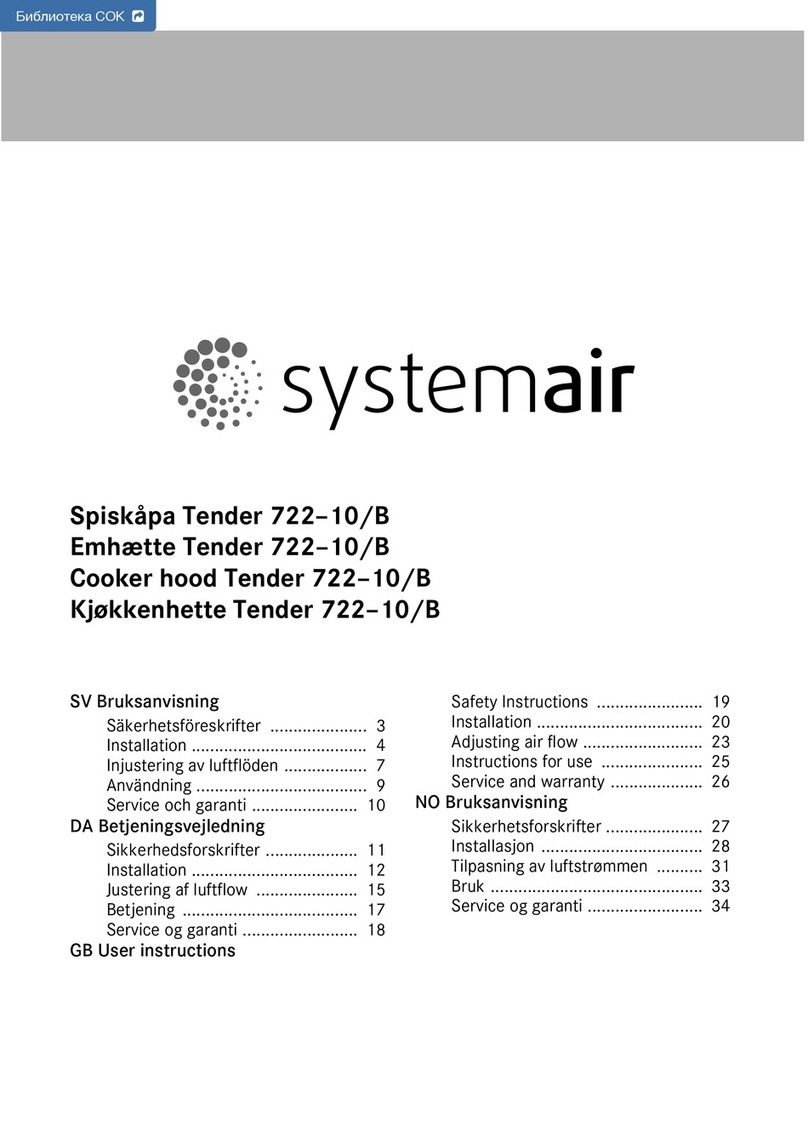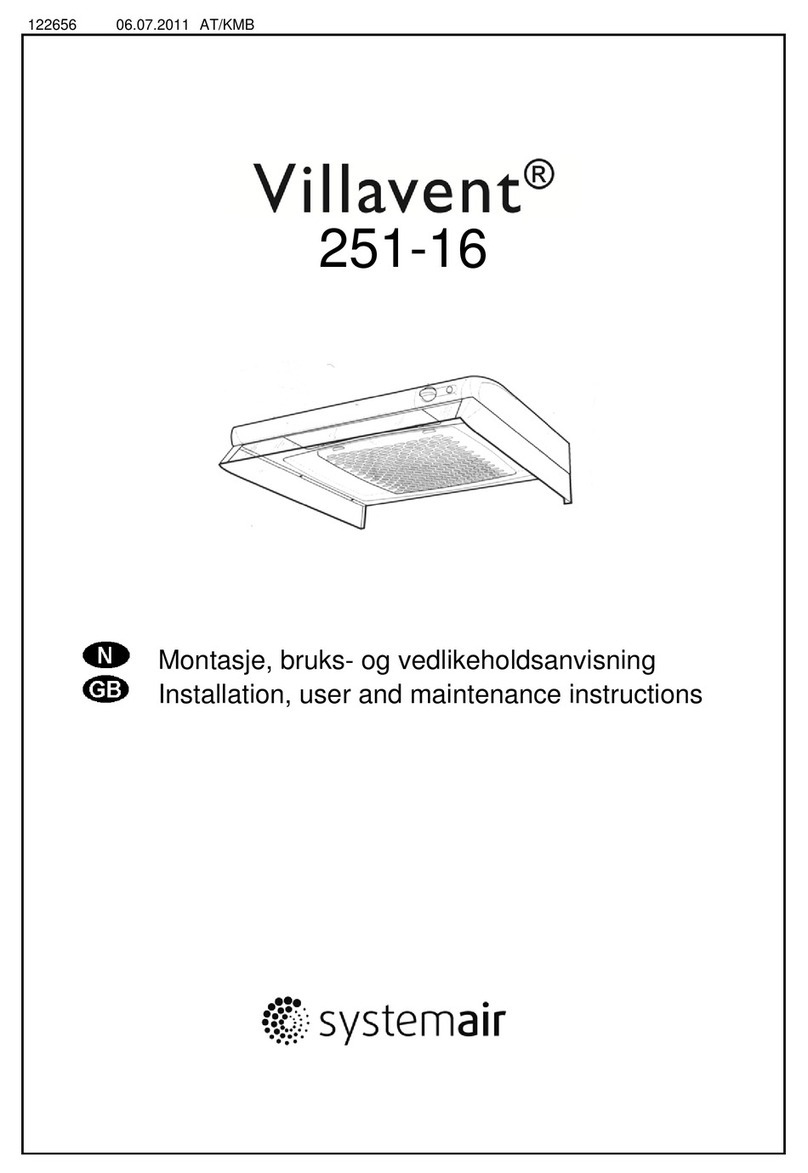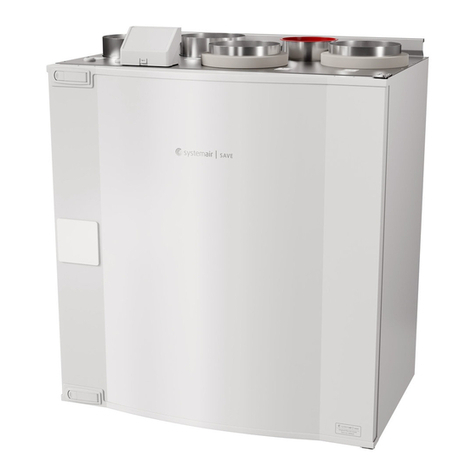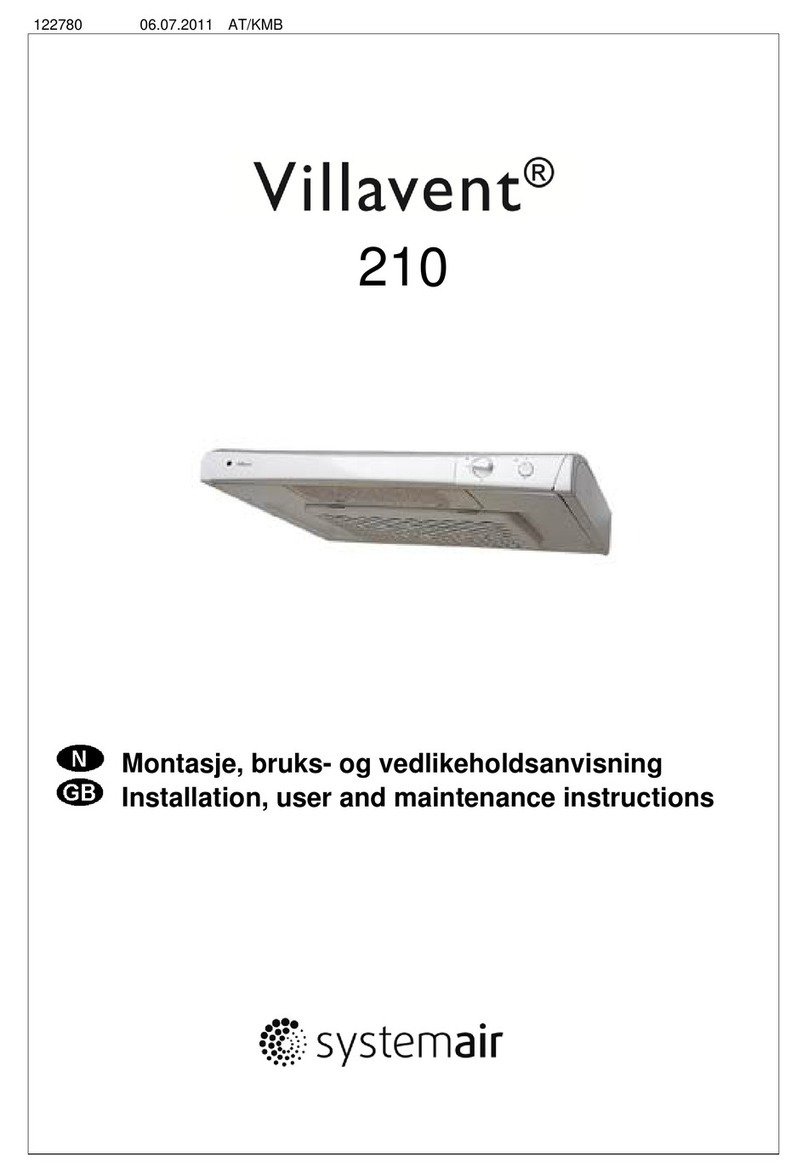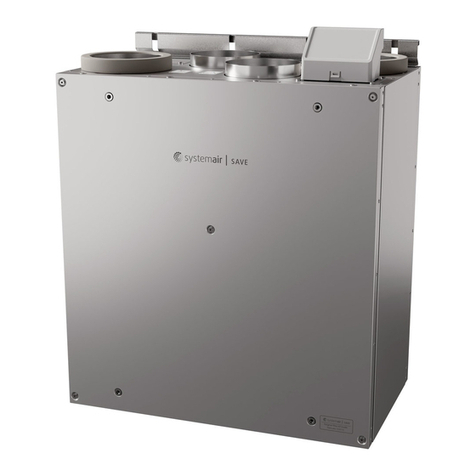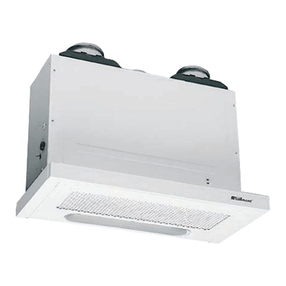
5
"Sommerbetrieb" und Zulufttemperatur
Tasten für Einstellung der max. Zulufttemp. Die
Zulufttemperatur kann in 5 Stufen (16-22°C) mit
den Tasten (9) + (10) nach oben/unten verstellt
werden. Die Lampen (6), (7) + (9) zeigen den
eingestellten Wert an.
Stufe 1 Lampe (6) leuchtet
Stufe 2 Lampen (6) + (7) leuchten
Stufe 3 Lampe (7) leuchtet
Stufe 4 Lampen (7) + (8) leuchten
Stufe 5 Lampe (8) leuchtet
Sobald die rückgewonnene Wärme aus der
Abluft nicht mehr ausreicht die eingestellte
Temperatur zu erreichen, schaltet sich auto-
matisch ein elektr. Nachheizrgister ein.
Die Lampe (14) leuchtet bei betrieb des NHR.
(Wir empfehlen die Zulufttemperatur so niedrig
als möglich einzustellen, jedoch so, daß Zugluft
vermieden wird. Hierdurch erhalten Sie die
größtmögliche Energieausbeute und den
besten Lüftungseffekt).
Filter
Die Lampe (11) leuchtet, wenn die Filter-
Standzeit abgelaufen ist (E, Fig.1). Die Lampe
(11) leuchtet auch, wenn das Gerät die Luft-
mengenbalance nicht halten kann (z.B. ein
Filter verstopft). Achtung! Störungen der
Luftmengen können auch auftreten, wenn die
Ventile verstellt werden oder das Außen-
ansauggitter verstopft ist. Das WRG-Gerät
kann auch ohne Filterwechsel weiterlaufen,
jedoch sinkt der Wirkungsgrad immer weiter
und der Luftmengenabgleich kann evtl. nicht
mehr erreicht werden. (es kann ein Unterdruck
bzw. Überdruch im Gebäude entstehen.). Die
Standzeit (6,9 oder 12 Monate) kann an der
Steuerung eingestellt werden (Montage-
anleitung). Die Filter-Standzeit muß nach dem
Wechsel neu aktiviert werden (siehe Wartung,
Punkt 1).
”Sommerbetrieb”
Sobald die Zulufttemperatur die eingestellte
Temp. übersteigt, bleibt der Rotor stehen und
es findet kein Wärmeaustausch mehr statt
(Sommerfunktion). Liegt die Ablufttemperatur
unter der Außenlufttemp. (wenn das Gebäude
klimatisiert ist), läuft der Rotor wieder an und
die Abluft kühlt die Zuluft im Tauscher. Die
Lampe (12, Fig.3) leuchtet solange der Rotor
steht.
"Summer operation" and supply air
temperature
Switches for choice of max inlet air temperature.
Supply air temperature is increased/ decreased
in 5 steps by pressing switch (9) and (10)
alternatively. Lamp signals (6), (7) and (8) show
set supply air temperature.
Step 1 Lamp (6) lights
Step 2 Lamp (6) and (7) light
Step 3 Lamp (7) lights
Step 4 Lamp (7) and (8) light
Step 5 Lamp (8) lights
When heat recovery from the extract air is in-
sufficient to obtain set supply air temperature, an
electrical heater battery will automatically be
switched on.
Lamp signal (14) will light up when the heater
battery is in operation. (In general it is re-
commended to set supply air temperature as low
as possible, avoiding the feeling of draught. This
gives the ultimate energy and ventilation
efficiency).
Filter
Lamp signal (11) comes on when set operation
time between changing of filters (E, fig. 1) has
expired. The lamp (11) will also light up if the unit
cannot maintain the correct air balance, f.ex. if
one of the filters is clogged. NOTE! Changes in
the air balance may also occur if the setting on
diffusers/louvers is being changed, if the fresh air
intake is clogged or similar. The ventilation unit
can still be operated, but the efficiency will be
reduced and the air balance in the building will be
changed (to increased over- or underpressure,
depending on which filter is being clogged) if the
filters are not replaced. Operation time (6, 9 or 12
months) between filter changes can be set on the
control panel (see installation instructions). Reset
operation time after having changed the filters
(see
MAINTENANCE
, item 1).
"Summer operation"
When supply air temperature exceeds set
temperature, the rotor will stop and there will be
no heat recovery (summer operation). If the
extract air temperature becomes lower than the
outdoor temperature (f.ex. if the building has
cooling/air conditioning installed), the unit will
automatically switch to recovery (of the chilled
indoor air). The extract air will then cool down the
inlet air in the exchanger. Lamp (12, fig. 3) lights
when the rotor is not in operation.
